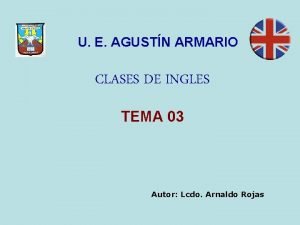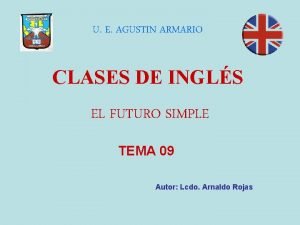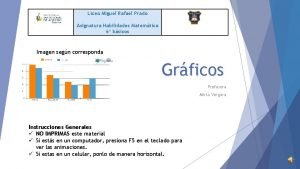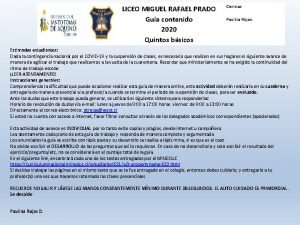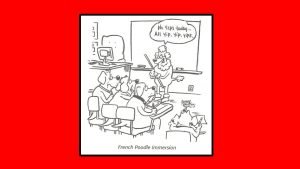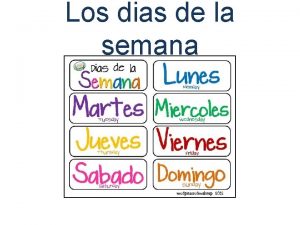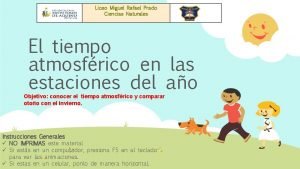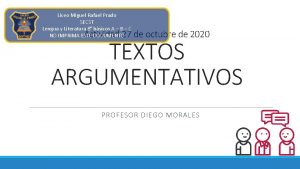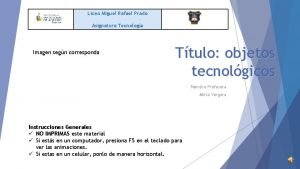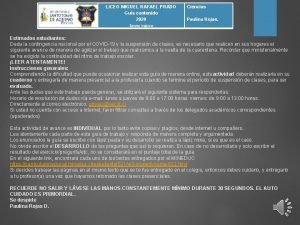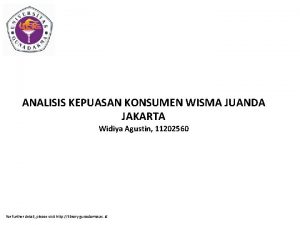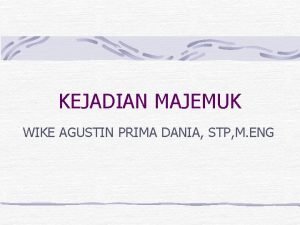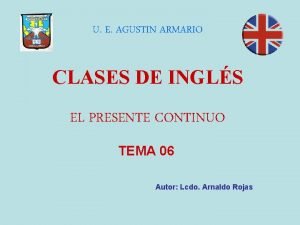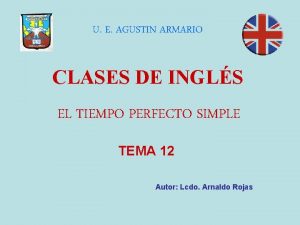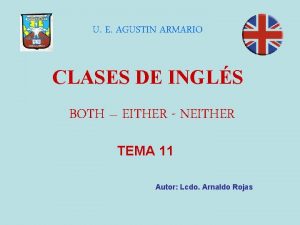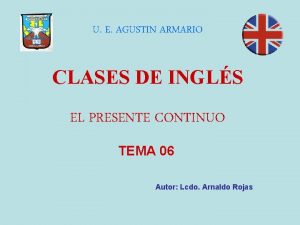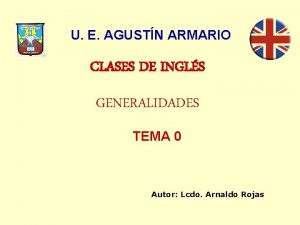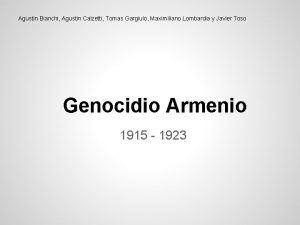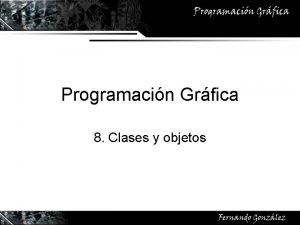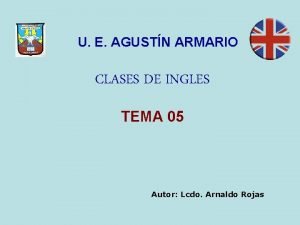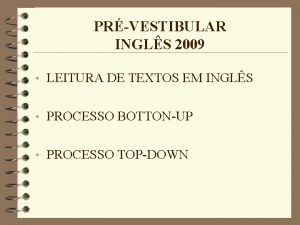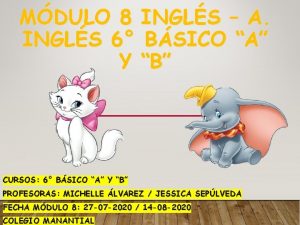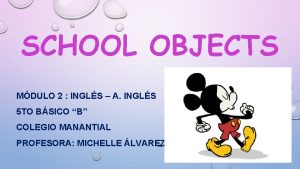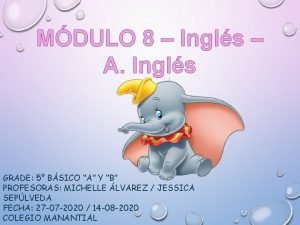U E AGUSTIN ARMARIO CLASES DE INGLS EL

















- Slides: 17

U. E. AGUSTIN ARMARIO CLASES DE INGLÉS EL FUTURO SIMPLE TEMA 09 Autor: Lcdo. Arnaldo Rojas

SIMPLE FUTURE 9. 1. - CONCEPTO Es un tiempo gramatical que indica una acción que se realizará en un momento próximo. 9. 2. - ¿QUÉ AUXILIAR SE USA? Se usa el Auxiliar WILL, el cual le da sentido de futuro al verbo que lo sigue, modificándolo. Se puede conjugar de igual forma con todos los Pronombres Personales o sus equivalentes. 9. 3. - ¿QUÉ TIEMPO DEBE TENER EL VERBO PRINCIPAL? El Verbo Principal tiene que estar en su forma natural o Presente (V), sin agregarle “s” o “es” aunque el sujeto sea Tercera Persona Singular.

SIMPLE FUTURE 9. 4. - ORACIONES AFIRMATIVAS EN FUTURO SIMPLE Una oración afirmativa en Futuro Simple se reconoce porque tiene dos (2) características que la diferencian de todos las demás oraciones afirmativas: 1. - Después del Sujeto, se escribe el Auxiliar WILL. 2. - Inmediatamente después se escribe el Verbo Principal en Presente (V) La estructura entonces, debe tener los siguientes elementos: S + WILL + V + C Donde, S, es el Sujeto de la oración; WILL, es el auxiliar que me transformará al verbo principal con sentido de futuro; V, es el Verbo Principal conjugado en Presente; C, es el Complemento el cual se puede usar con o sin una expresión de tiempo. Ex. : The Smiths will travel to Europe next week. Robert will eat a piece of cake.

SIMPLE FUTURE 9. 5. - ORACIONES NEGATIVAS EN FUTURO SIMPLE Una oración negativa en Futuro Simple se reconoce porque tiene dos (2) características que la diferencian de todos las demás oraciones negativas: 1. - Después del Sujeto, se escribe el Auxiliar WILL en su forma Negativa, es decir WON’T. 2. - Inmediatamente después se escribe el Verbo Principal en Presente (V) La estructura entonces, debe tener los siguientes elementos: S + WILL NOT + V + C Donde, S, es el Sujeto de la oración; WILL NOT, es el auxiliar Will en su forma negativa (Won’t); V, es el Verbo Principal conjugado en Presente; C, es el Complemento el cual se puede usar con o sin una expresión de tiempo. Ex. : The Smiths won’t travel to Europe next week. Robert won’t eat a piece of cake.

SIMPLE FUTURE 9. 6. - ORACIONES INTERROGATIVAS EN FUTURO SIMPLE Una oración interrogativa en Futuro Simple se reconoce porque tiene tres (3) características que la diferencian de todos las demás oraciones interrogativas: 1. - Se escribe el Auxiliar WILL al principio de la oración (WILL). 2. - Después del Sujeto se escribe el Verbo Principal en Presente (V) 3. - Al final se escribe el signo de interrogación cerrando (? ). La estructura entonces, debe tener los siguientes elementos: WILL + S + V + C + ? Donde, WILL, es el auxiliar; S, es el Sujeto de la oración; V, es el Verbo Principal conjugado en Presente; C, es el Complemento el cual se puede usar con o sin una expresión de tiempo; y, ? , es el signo de interrogación cerrando. Ex. : Will The Smiths travel to Europe next week? Will Robert eat a piece of cake?

SIMPLE FUTURE 9. 7. - RESPUESTA A LAS ORACIONES INTERROGATIVAS Una oración interrogativa con WILL, sólo admite 2 tipos de respuestas: SI o NO. Deben seguir por lo tanto la forma siguiente: Si la respuesta es afirmativa: Yes, S + Will Donde, Yes equivale a Si; S, es el sujeto de la oración; Will, es el auxiliar. Si la respuesta es negativa: No, S + Will Not (Won’t) Donde, No equivale a No; S, es el sujeto de la oración; Will Not, es la forma negativa del auxiliar. Examples Will Nancy eat bread? Yes, She will / No, She won’t. Will they live in Caracas? Yes, They will / No, They won’t.

SIMPLE FUTURE 9. 8. - USOS DEL FUTURO SIMPLE 1. - Cuando decidimos hacer algo al momento en que hablamos. What would you like to drink? I will have some coffee, please. 2. - A menudo lo usamos en las siguientes situaciones: 2. a. - Ofreciendo hacer algo. That problem looks different. I’ll help you solve it. 2. b. - Acordando o rehusando hacer algo. I’ve asked my father for some money, but he will not give it to me. 2. c. - Prometiendo hacer algo. I will be there on time. I promise. 2. d. - Pidiéndole a alguien que haga algo. Will you pass me he salt, please?

SIMPLE FUTURE 9. 9. - PREDICCIONES 1. - Cuando predecimos un hecho futuro o una situación futura, usamos WILL/WON’T. When you come back, you’ll notice my new look. Don’t worry about your English test. You’ll pass. 2. - WILL se usa a menudo con estas palabras y expresiones: Probably: I’ll probably buy a car this year. (I am) Sure: I am sure you will enjoy Martha’s company. She’s very nice. (I) Bet: I bet Peter will stop by at lunch time. (I) Think: I think my parents will come back this week. (I) Suppose: I suppose we’ll see Laura at the office. (I) Guess: I guess I’ll see you soon.

SIMPLE FUTURE 9. 10. - ¿CÓMO CAMBIAR CUALQUIER ORACIÓN A FUTURO SIMPLE, RESPETANDO SU ESTRUCTURA? Agregando, eliminando o cambiando los componentes de la oración, adaptándolos a la estructura correspondiente del Futuro Simple. Debemos, por tanto, reconocer las estructuras que usamos en el Futuro Simple, de acuerdo con la Fórmula de cada una. 1. - S + WILL + V + C = Es la estructura de una Oración Afirmativa en Futuro Simple. 2. - S + WILL NOT + V + C = Es la estructura de una Oración Negativa en Futuro Simple. 3. - WILL + S + V + C + ? = Es la estructura de una Oración Interrogativa en Futuro Simple. VER TEMAS 6 Y 7

FUTURE WITH TO BE GOING TO 9. 11. - CONCEPTO Es un tiempo gramatical que indica una acción que se va o que se iba a realizar en un momento inmediato. 9. 12. - ¿QUÉ AUXILIAR USA? Usa dos (2) Auxiliares: 1. - El verbo To Be, conjugado en Presente o en Pasado: TO BE (AM – IS – ARE) o TO BE 2 (WAS – WERE). 2. - El Participio Presente del Verbo To Go: TO GO 1 (GOING) 9. 13. - ¿QUÉ TIEMPO DEBE TENER EL VERBO PRINCIPAL? El Verbo Principal de este tipo de oraciones debe estar siempre en Infinitivo (V INF), es decir, con la Preposición TO al principio del mismo.

FUTURE WITH TO BE GOING TO 9. 14. - ORACIONES AFIRMATIVAS Se reconocen por el uso en Presente o en Pasado del Verbo To Be después del sujeto, más los otros componentes. The boys are going to need some money for eating. 9. 15. - ORACIONES NEGATIVAS Se reconocen por el uso de la Forma Negativa del Verbo To Be, en Presente o Pasado, después del Sujeto más los otros componentes. The boys weren’t going to need any money for eating. 9. 16. - ORACIONES INTERROGATIVAS Se reconocen porque al principio de la oración se halla la forma del Verbo To Be, en Presente o Pasado, seguido por los demás componentes de la oración, terminando con un signo de interrogación. Are The boys going to need any money for eating?

FUTURE WITH TO BE GOING TO 9. 17. - RESPUESTA A LAS ORACIONES INTERROGATIVAS Sólo admiten dos (2) respuestas: SI o NO, de acuerdo a la siguiente estructura: 1. - Si la respuesta es afirmativa: YES, S + TO BE/TO BE 2. 2. - Si es negativa: NO, S + TO BE NOT/TO BE 2 NOT. Ex: Is Susan going to live in Los Angeles? Yes, She is / No, She isn’t. Was Susan going to live in Los Angeles? Yes, She was / No, She wasn’t. NOTA: Tanto las estructuras como las respuestas, siguen el mismo patrón aplicado a cualquier oración que use el Verbo To Be como auxiliar.

SIMPLE FUTURE 9. 18. - PRACTIQUE. Answer these questions. 1. - Will you go out tonight? ______________________ 2. - When are you going to have a baby? ________________ 3. - Will they study Laws at the University? ________________ 4. - When will she come back? ____________________ 5. - What else is she going to do? ___________________

SIMPLE FUTURE 9. 18. - PRACTISE. (2) Answer this questionnaire. How do you see the future? Ten Years From Now… … will you be in the same house or apartment? … will you have a bigger house or apartment? … will you have a good job? … will you be unemployed? … will you be rich? … will you have more money than now? … will you be healthier than now? … will you be married? … will you have children? … will you speak English very well? Yes No Don’t Know

SIMPLE FUTURE 9. 18. - PRACTISE. (3) Write the appropriate question tag. 1. - You won’t do it anymore, __________ 2. - Mom will also get a doll for the baby, _________ 3. - He’ll call my friend to make an appointment, ________ 4. - We’re going to write a letter, __________ 5. - She isn’t going to apologize, _________ 6. - They will have little interest in that, _________ 7. - We won’t talk about that, ________ 8. - They’re going to be very happy, __________

SIMPLE FUTURE 9. 18. - PRACTISE. (4) Match the questions and answers. a. - Will you see Mary tomorrow morning? ___ I don’t think so. b. - She won’t accept that gift, _____? ___ I don’t know. Ask her. c. - Will your brother stay home tonight? ___ Of course, I am. d. - What is your sister going to do next Sunday? ___ Probable, I will. e. - Are you coming tomorrow? ___ will she?

¿Alguna Duda? NO TEMAN PREGUNTAR MUCHAS GRACIAS
 Presente simple con do
Presente simple con do Oraciones
Oraciones Preguntas de ciudadana 2020 en ingls
Preguntas de ciudadana 2020 en ingls Ingls
Ingls Preguntas de la ciudadana en ingls 2020
Preguntas de la ciudadana en ingls 2020 Ingls
Ingls Los días de la semana en inglés
Los días de la semana en inglés Preguntas de la ciudadana en ingls
Preguntas de la ciudadana en ingls Preguntas para la ciudadana en ingls
Preguntas para la ciudadana en ingls Preguntas de la ciudadana en ingls
Preguntas de la ciudadana en ingls 100 preguntas para la ciudadana 2020 en ingls
100 preguntas para la ciudadana 2020 en ingls Tiffany agustin
Tiffany agustin Imagenes de racionalismo
Imagenes de racionalismo He is the author of icnofalangometrica
He is the author of icnofalangometrica Systemic mycoses
Systemic mycoses Widiya agustin
Widiya agustin Wike agustin prima dania
Wike agustin prima dania Maria rosa guerrini
Maria rosa guerrini
